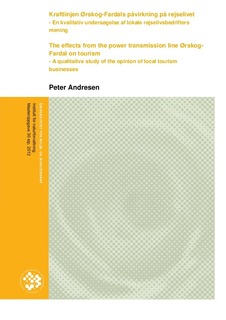Kraftlinjen Ørskog-Fardals påvirkning på rejselivet
Master thesis
Permanent lenke
http://hdl.handle.net/11250/186967Utgivelsesdato
2013-03-26Metadata
Vis full innførselSamlinger
- Master's theses (INA) [593]
Sammendrag
Norge kommer i de kommende år til at se en lang række kraftlinjeudbygninger, hvilket vil påvirke
en række samfundsaktører. Blandt andet vil rekreative interesser bliver berørt. Denne masteropgave
ser på hvordan rekreation i naturområder påvirkes af kraftlinjer. Opgaven tager udgangspunkt i et
konkret caseområde på den nordlige del af den kommende kraftlinje mellem Ørskog i Møre og
Romsdal og Fardal i Sogn og Fjordane. Det er et område med et veludviklet rejseliv og hvor
projektets konsekvensudredning vurderede at en kraftlinje ville få stor negativ indvirkning på
rejselivet. Fokus for opgaven er hvordan naturbaserede rejselivsbedrifter ser på kraftlinjen og de
påvirkninger den kan medføre. Problemstillingen for opgaven er:
Hvordan ser kommercielle rejselivsaktører i områderne omkring Geiranger- og Hjørundfjorden på
de mulige påvirkninger af den vedtagne kraftlinje mellem Ørskog og Fardal?
Foruden kraftlinjens påvirkninger, undersøges også holdningen til de forskellige tracévalg samt
bedrifternes opfattelse af de turistlandskab de opererer i.
Opgaven er gennemført som et kvalitativ studie af rejselivsbedrifter, hvor ialt 15 informanter deltog
i interviews. Interviewene blev udført i sensommeren 2012.
Opgavens resultater viser, at informanterne ikke troede at kraftlinjen ville betyde nogen
nævneværdig påvirkning af hverken rejselivet eller informanternes bedrifter. Det var en udbredt
accept at kraftlinjen, for at udbedre regionens problemer med strømforsyningen. Samtidig var der to
informanter der udtrykte bekymring for rejselivet i Hjørundfjorden.
De fleste informanter foretrak den koncessionsgivne tracé i Hjørundfjorden, frem for tracéen der gik
forbi Hellesylt og UNESCO-området som Geirangerfjorden er en del af. Selv bedrifter med
tilknytning til Hjørundfjorden foretrak den tracé, trods det at de ville få linjen tættere på. I forhold
til løsningen med et havkabel, mente nogle informanter at det var en bedre løsning rent visuelt,
mens andre mente at det var bedre at genbruge tracéen fra den eksisterende linje.
Det turistlandskab informanterne så, var et urørt landskab, men med en vis menneskelig påvirkning.
Kombinationen af kultur og natur var landskabets største fortrin i rejselivssammenhæng. Samtidig
gav de udtryk for at der var en bestemt grænse mellem de to, som ikke kunne overskrides uden at
påvirke rejselivet negativt. Abstract
In the coming years Norway faces a wide range of power transmission line extensions, which will
affect a number of community stakeholders. Among others, recreational interests will be affected.
This masters‘ thesis takes a closer look at how recreation in natural areas is affected by power
transmission lines. The thesis is based on a specific case area around the northern part of the future
power line between Ørskog and Fardal in western Norway. The area has a well-developed tourism
industry and the project impact calculation estimated that a power line would have a major negative
impact on the tourism in this area. The major research question that is sought in this masters‘ thesis
is:
How do the commercial tourism businesses in the areas around Geiranger and Hjørundfjorden
perceive the potential impact from the power line between Ørskog and Fardal?
In addition to the impacts of the power line, the thesis will also look at the attitudes towards the
different trench choices and the perception of the businesses of the tourist landscape they operate
in. The thesis is conducted as a qualitative study of tourism business, with a total of 15 informants
participating in the interviews. The interviews were conducted late in the summer of 2012.
The results shows that most informants did not believe that the power line would have any
significant impact on either tourism in the area or their own businesses. It was widely accepted that
the power line was going to be built, since it will overcome problems with the electricity supply for
the region. That being said, there were two informants who expressed concerns about the tourism in
Hjørundfjorden. Still most informants preferred that the concession were given to the trench in
Hjørundfjorden, rather than the trench that passed by Hellesylt and Geirangerfjorden, which is a
part of the UNESCO area. Even businesses related to Hjørundfjorden preferred that trench, despite
the fact that the line would be located closer to them. Regarding the alternative with a submarine
power cable, some informants believed that it would be a better solution due to its lower visibility,
while others felt that it would be better to reuse the trench from the existing power line. The
informants described the tourist landscape as an untouched landscape, but with a degree of human
influence. The combination of culture and nature was the biggest advantage of the landscape in a
tourism context. At the same time, the informants made it clear that there was a certain limit of
changes between the two that could not be exceeded without affecting the tourism negatively.
